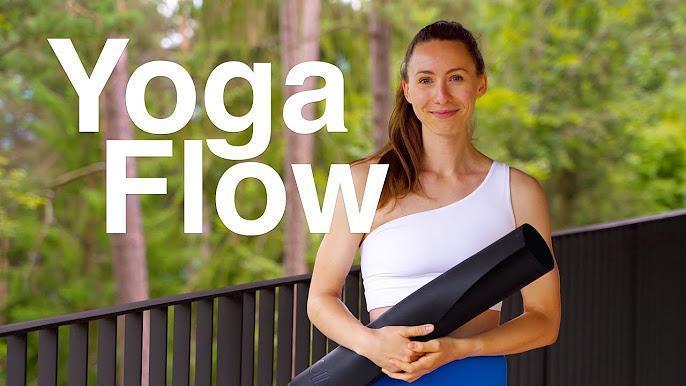If you’ve ever taken or taught a vinyasa yoga class, chances are you’re familiar with the transition from Virabhadrasana II (Warrior II Pose) to Viparita Virabhadrasana (Reverse Warrior) to Ardha Chandrasana (Half Moon Pose).
There’s nothing wrong with this common sequencing of poses. It’s familiar. It’s anatomically safe. And it feels almost intuitive.
Yet anything we do repeatedly can easily lend itself to us moving through the motions. Which is why it’s sometimes necessary to turn to less expected transitions into Half Moon Pose that will challenge not just your body but your mind.
How to safely sequence Ardha Chandrasana
When we transition between poses, it’s super common to think we should be focusing on what’s coming next, when actually we need to be hyper focus on being present. A trick to breaking down the transition between poses is to allow yourself to feel what’s happening in your body as it happens. Every transition is a play on balance—one part forward, one part backward. When you find that equilibrium, you’re more likely to move through the transition and into the following pose with more ease—even if it doesn’t feel easy.
5 ways to transition to Half Moon Pose
The best thing you can do while trying new transitions is breathe steadily and not take it too seriously. Since this is a balancing pose, you may want to grab some blocks as support. And remember, falling is a part of life.
Why this transition works: This transition takes you into a variation of Ardha Chandrasana that’s the same shape but with one knee on the mat for added steadiness. The transition is relatively intuitive as your shoulders and wrists are in a similar shape as Vasisthasana (Side Plank.)
This variation is essentially training wheels for the traditional expression of Ardha Chandrasana. It’s an excellent transition to include at the beginning of your practice if you’re going to practice one of the other transitions below.
How to: From Plank Pose, scooch your right wrist forward to where your right fingertips were a moment ago. Roll onto the outer edge of your right foot and stack your left foot on top of your right. Flex your toes towards your face. Lift both hips toward the ceiling. Then lift your left arm straight toward the ceiling to come into Vasisthasana (Side Plank).
Keep your left leg strong and your hips lifted as you lower your right knee to the mat beneath your right hip. Pivot on your right knee to bring your right shin and foot behind you like a kickstand. Lift your left leg parallel to the mat (but no higher than your hip) and press your lifted heel toward the back of your mat. To come out, lower your left leg and come to Tabletop. Repeat on the other side.
Parivrtta Utkatasana (Revolved Chair) to Ardha Chandrasana (Half Moon Pose)
Why this transition works: Actually, the first several times you attempt this transition, it might not feel like it works! As with anything worth knowing how to do, it takes practice—and this transition can remind you that it’s okay to be in a precarious position, falter, and regain your balance. The arm position in the twisted version of Chair Pose is perfectly aligned for coming into Half Moon. Pressing through your lifted heel is essential as you transition–this engages your core and stabilizes your balance.
How to: Start at the front of the mat with your feet hip-distance apart. Come into Utkatasana (Chair Pose). Bring your arms straight out from your shoulders and twist to face the left, initiating the movement from your mid to upper back. Your right arm will reach toward the front of the mat and your left arm toward the back. Press down through the pinky toe edge and heel of your right foot and slowly begin to lift your left knee towards your chest. Keep a slight bend in your right knee as you start to press your left heel toward the back of your mat. At the same time, lean your chest forward and reach your right arm toward the mat or a block. Lift your left arm to the ceiling until you find your way into Ardha Chandrasana. Try to stack your left shoulder over your right and your left hip on top of your right. To come out, slowly lower your left foot to the mat or challenge your balance and reverse how you came into the pose. Repeat on the other side.
Skandasana (Side Lunge) to Ardha Chandrasana (Half Moon Pose)
Why this transition works: Shifting your weight from your back foot to your front takes incredible strength, but your feet are already in position and you can use your momentum to help. This is a HUGE transition, so I recommend you take it slowly and with control. It helps to set up a block at the top of your mat, so once you’re ready to rotate your arms into Half Moon, the block is there if you need it to help with balance. Feel the movement and find your balance and grace.
How to: Start in Skandasana or Side Lunge, which is a mix of a yogi squat and a lunge facing the left side of the mat. Your left toes will be pointing towards the back left corner of your mat and bend your left knee in the same direction as your foot. Straighten your right leg toward the top of the mat and point your right toes toward the ceiling.
Bend into your right knee and start to bring your weight towards the center of your mat by leaning forward and pressing down with your left foot to transition into a mini–Goddess Pose. (You can bring your hands to the mat if you like.) Once you can’t bring any more weight in your right foot, rotate your left foot forward as you would in Virabhadrasana II (Warrior II Pose) and press your chest toward the front of the mat as you begin to lift your left leg. If you’re feeling super wobbly, press down through your big toe mound and heel. Then, continue to press your shoulders forward and rotate your left hip towards the ceiling to stack it on top of your right hip. Extend your arms straight out from your shoulders to find Half Moon Pose.
Trikonasana (Triangle) to Ardha Chandrasana (Half Moon Pose)
Why this transition works: Chances are you’ve already experienced the transition from Triangle to Half Moon. However, you can bring more easy and stability to it by taking your lower hand to your shin rather than let it dangle in space as you shift forward from Triangle.
How to: Start in Triangle Pose with your right leg towards the top of your mat in a straightened position and your left foot parallel-ish to the back of your mat. Keep your torso long as possible and press the crown of your head towards the front of your mat. Bring your right hand to your shin or a block placed just outside your right foot and lift your left arm towards the ceiling. The higher you keep your right hand on your shin, the easier the transition.
Begin to bend into your right knee while keeping your hand on your right shin, kind of like a super squishy Extended Side Angle. Once you can’t bend into your right knee any further, begin to lift your left leg by pressing your left heel towards the back of your mat and pulling up from your left glute. Either keep your right hand on your right shin for an extra challenge to your balance or bring it to the mat in front of your right foot.
Utkata Konasana (Goddess Pose) to Ardha Chandrasana (Half Moon Pose)
Why this transition works: Shifting from Goddess to Half Moon is actually play on the classic Warrior II to Reverse Warrior to Half Moon Pose sequence. You still get the same amount of external hip rotation in your leading leg that you get in Warrior 2, with the added bonus of getting external hip rotation in your back leg as well. This will help you feel the necessary movement and alignment needed for your floating hip in Half Moon Pose.
How to: Start in Goddess Pose, with your hips facing the long edge of your mat, your heels slightly in, and toes pointed outwards. Bring a bend into your knees and energetically pull your feet towards each other. Then bring your arms into a Warrior II stance where both arms are reaching towards the opposite ends of your mat. From here rotate your right foot to face the top of your mat and bring your weight into your right foot. At the same time rotate your left foot like it’s in Warrior II, slightly parallel to the back of your mat. Then, start leaning your chest to your right side and reach forward with your right arm until you can’t go any further. Once you’re here you can slowly bring your left leg off the mat and continue to lean your chest and right arm forward until you come into Half Moon Pose!
You can also transition backwards from Half Moon to Goddess Pose and straight into the other side for a playful approach.
This content was originally published here.




















